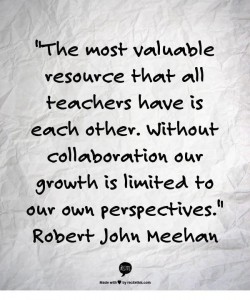Richard DuFour, one of the premier researchers on Professional Learning Communities (PLCs), emphasizes “the powerful collaboration that characterizes professional learning communities is a systematic process in which teachers work together to analyze and improve their classroom practices…work in teams, engaging in an ongoing cycle of questions that promote deep team learning…leads to higher levels of student achievement” (DuFour, 2004, 9). In developing a PLC, such as in a 9th grade academy model, teacher collaboration clearly plays an essential and critical role in the success of the program. This means collaboration among the teachers and collaboration within the surrounding community.

In the many definitions of a learning community, the primary goal is to ensure student achievement by asking three essential questions:
1. What does the student need to learn?
2. How do we know the student has learned it? (Notice that we do not ask whether the student has been taught the concept, but whether the student has learned the concept).
3. How do teachers respond when a student hasn’t learned the concept?
The works of Eaker, Fullan and DuFour all show that collaboration is an intense effort to answer these questions. This requires creating a common mission statement, which gives all the participants a sense of purpose as to why they are they. It requires having a common vision statement so that all may know where the school is going in the future. Lastly, it requires establishing a common set of values and goals that teachers and students can work towards (Lunenburg, 2010).
Teachers, when pressed, will often say “sure, we collaborate all the time!”. Often this translates to “I steal everything I have” and collaboration ends at the classroom door. Goddard,Goddard, and Tschannen-Moran conducted a large study investigating whether there was any direct correlation between teacher collaboration and student achievement. The results indicate that where there is collaboration for the sake of instructional improvement it is proven to directly correlate with student achievement(Goddard, Goddard, and Tschanen-Moran, 2007, 892). When teachers stop using professional development and collaboration as a way to find their next lesson plan and start using it to honestly improve instructional practice by asking the big questions, there is a proven increase in teachers attitudes about their profession and thus student success.
Collaboration is hard work, no doubt, and for that reason there is a lot of pushback from teachers who are not use to working like a team or who balk at the extra time, paperwork, or effort that PLCs require. Building a 9th grade academy requires that commitment to working together to improve instructional practice. There is a lot of evidence to show that often schools do not have a focus on collaboration, or provide ample time. In her research, Severage points out a often held point of view that teachers feel helpless in the face of the system to make any real changes. “Teachers can improve standardized exam results but cannot educate the public about the narrowness of the learning represented therein…streamline curriculum but cannot challenge its content or the stifling quantity of what is mandated…differentiate pedagogy to reach more diverse student populations but cannot ameliorate the effects of poverty and racisms…the perennial and systematic problems of education remain outside the scope of teachers improvement efforts, whatever forms these take” (Servage, 2008, 73). Teachers are very individual creators, love their creative license. Fighting against this it is easy to see how collaboration efforts may fail. In their review of the literature, Stoll, Bolam, McMahon and Thomas emphasize that in order for collaboration to be successful organizers of PLCs must pay attention to building trust, cooperation, time to work together, centrality of location and support that is conducive to creating success. It is also important to respect the individual and their ideas. Without these elements, you do not have true collaboration, nor can you hope for real improvement of instruction practice.
Citations:
DuFour, R. (2004). What is a” professional learning community”? Educational leadership, 61(8), 6-11.
Lunenburg, F. C. (2010, September). Creating a professional learning community. In National forum of educational administration and supervision journal (Vol. 27, No. 4, pp. 1-7).
Goddard, Y. L., Goddard, R. D., & Tschannen-Moran, M. (2007). A Theoretical and Empirical Investigation of Teacher Collaboration for School Improvement and Student Achievement in Public Elementary Schools. Teachers College Record, 109(4), 877-896.
Servage, L. (2008). Critical and transformative practices in professional learning communities. Teacher education quarterly, 35(1), 63-77.
I agree that collaboration is more than just sharing information – it is definitely intended to be a two-way street. This is one of the reasons why, based on DuFour’s (among others’) work, we had specific protocols in place for Learning Team facilitators to follow. The protocols help guide the conversation and foster participation by all members of the group. Without full participation, everyone in the group does not benefit from the collaboration – and neither, then, do students.
Professional Learning Communities benefit everyone! Done effectively, I have seen growth in teachers and student achievement. As a former school administrator, the more effective PLC Meetings were ones I attended and participated in. Teachers felt more supported and the quest for increasing student achievement was viewed as the responsibility of everyone and not just a few selected grade level members. Planning for lessons was more effective and incorporated more differenentiated instruction as teachers shared freely more strategies to implement with students. This type of planning also encouraged individualized instruction and the grouping of students was enhanced when the lessons were planned for each one rather than for the good of all.